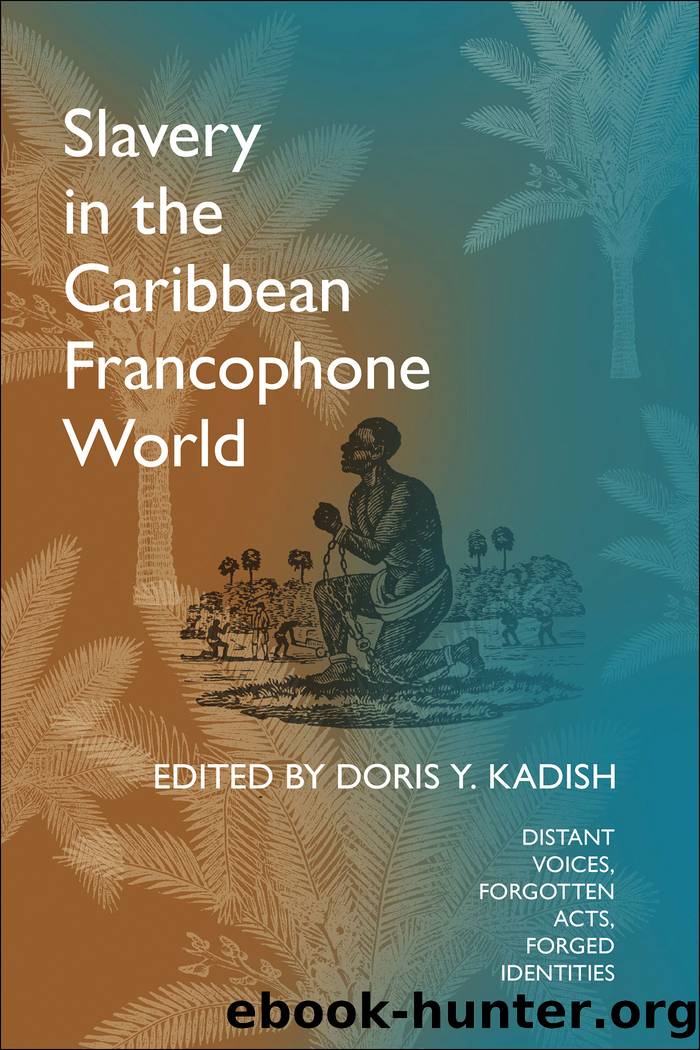Slavery in the Caribbean Francophone World by unknow

Author:unknow
Language: eng
Format: epub
Publisher: Lightning Source Inc. (Tier 3)
Published: 2016-07-15T00:00:00+00:00
NOTES
1. Throughout this work I use the inclusive somatic terms free black, free person of color, and libre to encompass anyone of African descent, that is, any free nonwhite person whether he or she be pure African, part white, or part Native American. The exclusive terms pardo (light-skinned) and moreno (dark-skinned)âpreferred by contemporary free blacks over mulatto and negroâare utilized to distinguish elements within the nonwhite population.
2. Louisianaâs colonial period lasted from 1699, when the French established a permanent settlement in the area, to 1803, when the United States purchased it. France ceded Louisiana to Spain in the Treaty of Paris of 1763, and Spanish administrators governed the colony until 1803. During French and Spanish rule, Louisianaâs value to Europeans was mainly strategic. Both countries viewed Louisiana as useful within the context of larger geopolitical considerations: they wanted to keep the colony out of the hands of archrival England. Although European rulers put more resources into the colony than they got out, France hoped that by occupying Louisiana it could gain access to silver mines in northern New Spain. Spain, in turn, sought Louisiana as a protective barrier between those same mines and Britainâs increasingly expansive North American colonies to the east. For more on Louisianaâs early history and its geopolitical role, refer to Bennet H. Wall, ed., Louisiana: A History (Arlington Heights, Ill.: Forum Press, 1990), and David J. Weber, The Spanish Frontier in North America (New Haven: Yale UP, 1992).
3. On this topic, see David Barry Gaspar and David Patrick Geggus, eds., A Turbulent Time: The French Revolution and the Greater Caribbean (Bloomington: Indiana UP, 1997).
4. Lewis Hanke, The Spanish Struggle for Justice in the Conquest of America (Boston: Little, Brown, 1949); Lyle N. McAlister, âSocial Structure and Social Change in New Spain,â Hispanic American Historical Review 43, 2 (April 1963): 349â70; and Lyle N. McAlister, Spain and Portugal in the New World, 1492â1700 (Minneapolis: U of Minnesota P, 1984), 24â40, 398â401.
5. Kimberly S. Hanger, Bounded Lives, Bounded Places: Free Black Society in Colonial New Orleans, 1769â1803 (Durham, N.C.: Duke UP, 1997), 22.
6. Herbert S. Klein, African Slavery in Latin America and the Caribbean (New York: Oxford UP, 1986), 217â41.
7. Quote from Thomas Marc Fiehrer, âThe African Presence in Colonial Louisiana: An Essay on the Continuity of Caribbean Culture,â in Louisianaâs Black Heritage, ed. Robert R. Macdonald, John R. Kemp, and Edward F. Haas (New Orleans: Louisiana State Museum, 1979), 18; Carl A. Brasseaux, Denis-Nicolas Foucault and the New Orleans Rebellion of 1768 (Ruston, La.: McGinty, 1987); Laura Foner, âThe Free People of Color in Louisiana and St. Domingue: A Comparative Portrait of Two Three-Caste Slave Societies,â Journal of Social History 3, 4 (1970): 415â16, 418â19. A âtenuous allegiance of the dominantly French planters to the Spanish regimeâ posed perennial challenges to Spanish administrators in Louisiana. An analysis of the correspondence of Governor Carondelet, who served during the era of the French Revolution, particularly highlights this dilemma (see Fiehrer, âAfrican Presence,â 16, 25).
8. Gilbert C. Din, âProposals and Plans for Colonization in Spanish Louisiana,â Louisiana History 11, 3 (1970): 197â213.
Download
This site does not store any files on its server. We only index and link to content provided by other sites. Please contact the content providers to delete copyright contents if any and email us, we'll remove relevant links or contents immediately.
| General | Discrimination & Racism |
Nudge - Improving Decisions about Health, Wealth, and Happiness by Thaler Sunstein(7471)
iGen by Jean M. Twenge(5334)
The Fire Next Time by James Baldwin(5207)
Adulting by Kelly Williams Brown(4445)
The Hacking of the American Mind by Robert H. Lustig(4271)
The Sports Rules Book by Human Kinetics(4222)
The Ethical Slut by Janet W. Hardy(4153)
Captivate by Vanessa Van Edwards(3772)
Mummy Knew by Lisa James(3590)
In a Sunburned Country by Bill Bryson(3457)
The Worm at the Core by Sheldon Solomon(3401)
Ants Among Elephants by Sujatha Gidla(3369)
Suicide: A Study in Sociology by Emile Durkheim(2953)
The Slow Fix: Solve Problems, Work Smarter, and Live Better In a World Addicted to Speed by Carl Honore(2918)
The 48 laws of power by Robert Greene & Joost Elffers(2899)
Humans of New York by Brandon Stanton(2751)
Handbook of Forensic Sociology and Psychology by Stephen J. Morewitz & Mark L. Goldstein(2642)
The Happy Hooker by Xaviera Hollander(2631)
The Tipping Point by Malcolm Gladwell(2627)
